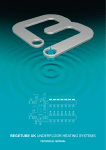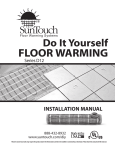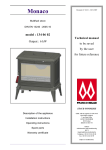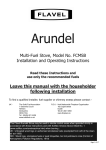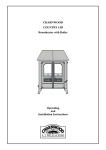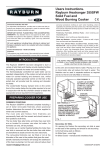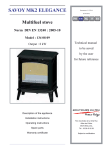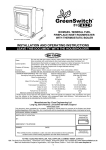Download 0800 02 22 20†
Transcript
npm3698_HYHome(9.06) 1/9/06 15:17 Page 1 If you’d like to find out more, or would like to chat to one of our team about energy efficiency in your home, please call our FREE Energy Efficiency Helpline on; † 0800 02 22 20 or visit www.npower.com Energy Efficiency Heating your home This has been printed on environmentally friendly paper. † Calls may be monitored and recorded for training and security purposes. Lines are open Monday to Friday 8am - 6pm, Saturday 9am - 12pm. npower is a registered trade mark and the trading name of Npower Limited (registered in England and Wales No. 3653277), Npower Gas Limited (registered in England and Wales No. 2999919) and associated companies. Registered office: Windmill Hill Business Park, Whitehill Way, Swindon SN5 6PB. npm3698/09.06. npm3698_HYHome(9.06) 1/9/06 15:17 Page 3 Contents Storage Heating Storage heating 3 Direct electric heating 7 Gas central heating 8 Electric storage heating is a great way of making the most of low-cost electricity on Economy 7 or other ‘off-peak’ tariffs. A storage heater can take in electricity overnight - when it’s at its cheapest. It then stores the electricity as heat, which can be released evenly during the following day Storage heaters are ideal for providing background warmth, and they work well alongside other types of heating which can ‘top-up’ temperatures when you need them to. Don’t be tempted to turn storage heaters off or down though to use a fire instead this is likely to cost you a lot more money. Which storage heating system? Storage heaters - are the most popular storage heating system and they can be really economical. Some have controls for you to set the amount of electricity the heater takes in, but the more efficient storage heaters have automatic controls. Sensors on the heater measure room temperature overnight to calculate and store exactly the right amount of heat for the following day. During the day, a damper at the top of the heater gradually releases more heat as it’s needed. Storage heaters are ideal for most rooms, but not so great for small bedrooms or rooms you don’t often use. Combi heaters - combine the advantages of a storage heater and a direct-acting panel heater. They’re ideal for living areas as they can be both economical and flexible. Storage fan heaters - are similar to storage heaters but have a fan in the base of the unit to speed up the release of heat. These heaters have a programmer or thermostat and are really easy to control. They’re suitable for the living areas in your home you use most. Electricare - is a ducted warm air central heating system. Heat is stored overnight in a central unit and is distributed to rooms through vents at times set by a central programmer. A room thermostat in the living room or hall controls the different temperatures. However, unless you’re planning major building work in your home, it’s really difficult to fit electricare into a house that’s already been built. An electric boiler - is a ‘wet’ central heating system. You can have an electric boiler fitted in any home, you just need to check you can connect it to your existing radiator system and that you’ve got space for it. Heat is stored overnight in the central boiler and its release is controlled by a programmer and room thermostat or thermostatic radiator valves (TRVs). Floorwarming - uses cables or hot water pipes ‘buried’ in a concrete floor. Heat is stored in the concrete during off-peak hours and is controlled with a thermostat. The efficiency of the system is affected by the floor coverings you choose. You should only really consider fitting a floorwarming system if you’re building a house or extension. The whole system must be professionally designed and fitted. 3 npm3698_HYHome(9.06) 1/9/06 15:17 Page 5 Using electric storage heating efficiently – some top tips! • If your storage heaters aren’t automatic, you can make the most of them by using the controls wisely. It’s best to turn up the input control gradually as the weather gets colder and turn it down gradually as the weather gets warmer. The manufacturer’s instructions may also help, or you can give us a call for more advice and tips. • If you find you need more heat at certain times of the day, you can use the damper control at the top of your heater to release more heat. Don’t forget to return the control to its ‘minimum’ position before you go to bed to save energy overnight. • Don’t turn to other types of heating until you’ve had a good look at the controls on your storage heaters to check you’re getting the most out of them. • Fit shelves above storage heaters to push heat towards the middle of the room and away from the ceiling. Make sure you leave enough room for air to move freely between the top of the heater and the shelf. • It’s best not to put furniture directly in front of heaters. And never hang washing on them or cover them with curtains. • If you have electricaire, make sure the ducts are not blocked and clean the filter regularly. • If you go on holiday leave your storage heating system on but turn it down. This will help stop your home getting cold and damp while you’re away. • Fit storage heaters away from doorways, windows and other draughts which could affect the sensor which measures the room temperature. The draught will lower the temperature around the sensor, which may make it take in more heat than necessary. • Insulate your home to keep the heat in – and the cold out! • If you’re considering having a heating system installed, seek expert advice on the design and installation from a qualified contractor. Heating check • Once in a while, take time to look at your heating system and check it over: • Are all the heaters and radiators working correctly? • Have you set the controls to the best position? If you’re not sure, we can advise you. • If you’ve got a radiator system, have you set the thermostatically-controlled radiator valves (TRVs) correctly? • Is a gas fire or other heating appliance interfering with the how much electricity your storage heating system is taking in? If you’re topping up the temperatures with other heaters then the sensors on the storage heater won’t register the need to store heat overnight. • Are you making the best use of timers and thermostats? • Are they in the right room and position in the room? • Are the settings on them correct? How to use the input and output controls Most storage heaters have two dials, which make it fairly easy to control heater input and output. The INPUT control determines how much heat is stored and the OUTPUT control determines room temperature. Both controls are usually found on top of the heater under a flap. Some storage heaters have an automatic input, which senses room temperature in order to decide how much heat to store overnight. Input control - If you’ve got manual heaters then the input control should generally be increased as the weather gets colder. Set it between two and four during autumn and spring, and up turn it up to maximum in the depths of winter. For automatic heaters you’ll only need to adjust this control to suit you and the temperatures you find comfortable. Once you’ve set it you should be able to leave the heater to control the input according to the temperature of your room at night (which generally follows temperatures outside). It’s important to remember that using top-up heat from a gas or electric fire late into the night could affect the input to an automatic storage heater. Output control - The output control should only be turned up during the day when you want more heat and always turned down at night before you go to bed. For maximum efficiency, keep the output control on the lowest setting during the day. Increase to a higher number in the evening to turn up the heat then turn it back down to the lowest setting at bedtime. If you’ve got Creda, Dimplex or Berry heaters then this guide will help you to use these controls effectively and efficiently. • Are there any rooms you’re not using where you could reduce the temperature? 4 5 npm3698_HYHome(9.06) 1/9/06 15:17 Page 7 Types of heaters Direct electric heating Dimplex heaters If you’ve got a Dimplex automatic storage heater, the initial setting on the righthand/automatic input dial should be between four and six. After the first night’s charge you’ll be able to judge whether the room temperature is too high or too low. Adjust the dial up or down until you find the position that gives you the comfort you need - then leave it in this position. This ranges from portable appliances like electric fires, to fixed systems such as panel heaters and ceiling heating. The most important thing to remember about direct electric heating is that you could waste a lot of electricity if you try to boost the heat in your home quickly and then leave the heating set too high. The best way to use direct heating is to: You can generally leave the left-hand/room temperature boost dial set at one, but if you want more heat then you turn it up as high as level nine. This will open the damper and release more heat. If you do use the dial it’s important to turn it back to one before going to bed. • Use the right heater, in the right place, for the right job. • Control the temperature and the time you have the heating on. • Be aware of the times when electricity is cheapest and take advantage. Choosing the right direct heater With Dimplex ultra-slim storage heaters, set the right-hand input dial to the maximum level of nine in cold weather and a lower position in milder weather. There are three types of direct heater: Creda heaters If you have an automatic Creda TSR heater then the input control will work in a similar way to the Dimplex automatic model. It could take you a couple of days of trial and error to find the right levels to keep you warm, but once you’ve got it right the heater will charge automatically each night depending on the weather conditions. • Forced convection heaters - these heat the air, for example fan heaters. • Radiant heaters - these heat surfaces but not the air, for example infra-red heaters. • Combination heaters - these combine the two, for example panel heaters and convector heaters. Unless you fit a specially designed system in a highly insulated home, it’s usually less economical to rely on direct acting heating for all your heating needs. If you’re not sure, give us a call and we’ll be happy to help. If you’ve got a manual heater, the input control should be adjusted following seasonal changes in the weather. Avoid changing the setting daily as two or three times a heating season should be enough. Use a setting of between one and three in the autumn and gradually increase it with the onset of winter. Reverse the pattern as winter turns to spring. • Infra-red heaters are great for the rooms you only use for short periods of time (your bathroom for example). It’s best to fit them at a high level pointing downwards. A fan heater is another good option - fixed to the wall and fitted with a timer and thermostat. The output control can be left on the minimum setting during the day, turned up as much as you want in the evening. Always remember to turn it back down at bedtime. • For rooms which you rarely use and don’t need to keep heated constantly (a spare bedroom for example), fit a panel heater with a timer and thermostat. You can plug this heater into a standard wall socket if it’s 3kW or less. Fix the heater under the window to Berry heaters In addition to the usual output and input controls on the top of the heater, Berry heaters have a ‘comfort level’ switch on the lower right-hand side of the casing. This means they can be used either as a manual or as an automatic system. Automatic operation is recommended as it’s more economical to run. Set the input control to maximum and adjust the comfort control daily until you find level of warmth you want. Leave the output control at minimum unless you need more heat during the day. To operate the heater manually set the comfort control to maximum and adjust the setting of the input control according to the weather. Leave the output control on minimum unless you need more heat during the day. make up for any draughts, but don’t cover it with curtains. Alternatively, use an oil-filled radiator, a convector heater or a fan heater. • Heating conservatories and workshops with direct heating can be expensive, so think carefully about the type of heater you choose. Match it to the way you plan to use the room. Do you really need to heat the whole area, or do you just want heat in one place whilst you’re in there? All direct heaters have their limitations. It’s no good expecting a one-bar fire or a small fan heater to heat a large room on its own. Quartz heaters are recommended for conservatories and workshops. They were originally developed for business and industry and can be controlled by a switch or by a movement detector. If condensation is a problem, you may be better to use a dehumidifier as well as, or instead of, heating. If you’re not sure which sort of direct heater to choose give us a call and we’ll be happy to help. Safety 6 • Don’t use portable electric heaters in bathrooms • Be careful not to trip over trailing leads to portable heaters • Keep direct heaters away from furniture, furnishings and anything that may catch fire Make sure heaters have a suitable guard around them and never leave small children alone with them. 7 npm3698_HYHome(9.06) 1/9/06 15:17 Page 9 Typical costs What to consider when you choose a new boiler Heater Type kW Rating Amount of warmth produced by one unit of electricity Panel heaters Fan heaters Convector heaters Coal or log-effect fires 1.5 2 2 1 (1 bar) 2 (2 bars) 3 (3 bars) 0.5 40 minutes 30 minutes 30 minutes 1 hour 30 minutes 20 minutes 2 hours Oil-filled radiators Thinking of buying a new boiler? Think through the points below to help you choose the right one: • What types of fuel are available? What will your fuel costs be like? • How efficient is the boiler? The more efficient it is, the cheaper your energy bills will be. • Will you need a chimney or flue? • Where can you put the boiler? How much space do you have? • Is the system convenient for you and easy to use? Gas Central Heating • How much service and maintenance will it need? This could affect long term costs. • Will you need to store fuel? Where could you store it? The boiler is the heart of the central heating system, supplying heat to the radiators and domestic hot water. There are different types of boiler: The conventional boiler - is either floor standing or wall mounted and is the most common type of boiler you’ll find. • Will you need storage tanks or cylinders for water? Remember, when you’re comparing costs take into account all the points above and not just the price of the boiler itself. Typical running costs The condensing boiler - is the most efficient boiler available. The back boiler – this is fitted into a fireplace opening. Typical yearly running costs for a central heating system in a three bedroom semidetached house in the Midlands: The combination boiler (combi) - does the work of both central heating boiler and hot water cylinder, so there’s no need for a separate hot water cylinder. Type of boiler The thermal store - is a system that provides space heating and mains pressure hot water in conjunction with a gas boiler. Gas conventional boiler £xxx Gas instant water heater boiler – is for hot water only, and is generally wall mounted in a kitchen or bathroom. Gas condensing boiler Oil conventional boiler £xxx Gas circulator boilers - is a small boiler for hot water only. It supplies a hot water storage cylinder. Oil condensing boiler £xxx Solid fuel open fire with back boiler using housecoal group A (there are other solid fuels you could use) £xxx Solid fuel room heater with back boiler, using Anthracite nuts (there are other solid fuels you could use) £xxx Solid fuel gravity feed boiler using Anthracite grains (there are other solid fuels you could use) £xxx LPG conventional boiler £xxx LPG condensing boiler £xxx Oil boilers - the range of oil boilers is similar to that of gas. To use an oil fired boiler, you’ll need plenty of space for the oil storage tank. Solid fuel back boilers - these are fitted behind an open fire or solid fuel room heater (a fire which is closed at the front with a glass or metal door). Automatic solid fuel boiler - this is an independent solid fuel boiler, which supplies central heating radiators and hot water taps. Kitchen range - this is traditionally a solid fuel cooker, with a boiler included to supply hot water and central heating radiators. It’s expensive to install, and not particularly cheap to run. 8 Running costs including any standing charges, renting a fuel tank and maintenance 9 npm3698_HYHome(9.06) 1/9/06 15:17 Page 11 Boiler efficiency Setting temperature controls To provide a guide for consumers on the relative efficiencies of boilers, a scheme has been developed to rate boilers from ‘A’ to ‘G’. Whilst there’s no requirement for manufacturers to label boilers, those that are labeled have a tested level of efficiency. It makes sense when choosing a new boiler to check the efficiency rating. Boiler thermostat You’ll find your boiler thermostat on the front of your boiler. It controls the temperature of the hot water produced by the boiler, switching the boiler off when the set temperature is reached. If your heating system has thermostats for both your rooms and your hot water, it’s best to set the boiler thermostat to maximum and use the other thermostats to set comfortable room and hot water temperatures. If there are no temperature controls, then the boiler thermostat should be set as follows: Band SEDBUK Range A 90% and above B 86% - 90% C 82% - 86% D 78% - 82% Control (oC/oF) Winter (82oC/180oF) 1-4 E 74% - 78% F 70% - 74% G Below 70% Source: SEDBUK (Seasonal Efficiencies of Domestic Boilers in the UK). www.sedbuk.com 4 2 8 Max High 4 Midway Between Min & Max Low The setting variations allow for different heating needs. A well insulated home will need lower settings than the same home without insulation. Condensing boilers will be rated ‘C’ and above, and are available as conventional or combi boilers. Since August 2002, boiler installers have been legally required to install boilers rated D or above. Combi boilers usually have ‘summer’ and ‘winter’ settings. The ‘winter’ setting is for heat and hot water, the ‘summer’ setting is for hot water only. Lighting the boiler Room Recommended room temperature Living rooms 21ºC Bedrooms, kitchen, bathroom 18ºC Hall 16ºC Most modern boilers have an electronic ignition that lights the burner automatically when you use the controls to trigger more heat. Older boilers have a pilot light to light the burner. The pilot light should not be turned off except under instruction from a gas service engineer, for example when the system is decommissioned for a length of time. A pilot light adds to the cost of running the boiler. The importance of regular servicing Gas appliances need to be serviced regularly to ensure they’re working efficiently and safely. Ideally you should have your heating appliances (i.e. fires, water heaters and central heating boilers) serviced every year. Other gas appliances should be serviced every two years. Only allow service engineers who are registered with CORGI to work on your gas appliances. 10 1-8 Min-Max High-Low Summer (70oC/160oF) Room thermostats control the temperature in the home by turning the boiler on and off. These figures are given for guidance only, heat your home to the temperature you are comfortable with. Radiator valves Radiators have individual control valves at either end. One valve is set when the system is installed and should not be adjusted. The second valve, recognised by an arrow on top, can be opened or closed as indicated by the arrow. Hot water cylinder thermostats control the temperature of hot water stored in the cylinder. The thermostat should be set at no more than 60ºC/140ºF. Time switches and programmers Time switches and programmers are used to control when the heating system turns on and off. They can range from a simple clock, which sets one or two on/off periods a day, to advanced programmers, which allow multiple time periods to be programmed and variation in the programme over different days. 11 npm3698_HYHome(9.06) 1/9/06 15:17 Page 13 Time switches These are the simplest form of control. The switch consists of a 24-hour clock and four tappets to set the on/off periods. If the tappets are identified 1 to 4 or A to D it’s important that they’re set in the correct order. Programmers These work in the same way as time switches but are more sophisticated in that they allow heating and hot water to be programmed separately. Programmers are easy to set if you follow the manufacturer’s instructions. If you’ve got a gas warm air system, the hot water can be provided by either an electric immersion heater or by a separate gas circulator. The gas circulator is a small boiler fitted either next to the warm air unit or beside the hot water cylinder. If you’ve got a gas fire, the circulator may be fitted behind it, in the same way as a back boiler is, as described earlier. The controls are an on/off switch with a pilot light. There may be a thermostat for your boiler and your cylinder. These should be set as described earlier, but if in doubt check the manufacturer’s instructions. Programming for hot water only During warm weather you may want your system to produce hot water only. Turn the heating off at the programmer or time switch. If this is not an option, turn the room thermostat or TRVs to their lowest setting. Combi boilers have ‘winter’ and ‘summer ’or ’hot water only’ settings. Turn to the appropriate setting. In ‘summer’ or ’hot water only’ mode the heating part of the boiler doesn’t work. Warm air heating Warm air heating systems heat the air with a central unit and then circulate it with a fan. The hot air passes through ducts built into the walls, floors and ceilings, and then emerges through grilles to heat each room. The warm air central unit is the equivalent of the boiler in a conventional system but it heats air instead of water. It can be fuelled by gas or electricity - in the case of electric warm air, the heat is stored in the unit during the off-peak hours at night and then used during the day to warm the air. Methods for lighting gas warm air units vary so check the instructions with the unit – they’re usually attached to the inside cover of the heater. Most warm air units have an air filter - you’ll need to clean this regularly for the system to work efficiently. If the warm air unit is fitted in a cupboard, make sure that items stored around it do not block the airflow. Controls are usually a room thermostat and time switch - use these as described earlier in this booklet to control the heating. Warm air enters each room through the outlet grille. The grilles are slatted so you can open or close them to control room temperature. Be careful not to close the grille in the room with the thermostat, as this will affect the heating in the rest of the house. Hot water Hot water is not provided by warm air units, so separate water heating is required. With electric warm air this will be by means of an immersion heater, usually operated by a time switch to use off-peak electricity. If you’ve got a warm air unit you’ll need a separate water heating system for your hot water. If your warm air unit runs on electricity, you’ll probably have an immersion heater which are usually operated by a time control to take advantage of off-peak electricity. 12 Wall heaters Wall mounted gas convector heaters are individual balanced flue units which provide an economical alternative to gas central heating, particularly in energy efficient modern starter homes. There are two types: • individual heaters fitted onto outside walls which operate independently • fanned flue heaters - fitted onto internal walls with a fan assisted flue to expel the combustion gases Wall heaters are usually manually controlled, but some wall heater systems are controlled by programmers and room thermostats. These should be set and used as already described. If there’s a room thermostat, set the wall heater thermostat to full. If not, set the thermostat at the temperature you want for your home. 13 npm3698_HYHome(9.06) 1/9/06 15:17 Page 15 Going on holiday When you go on holiday it makes sense to adjust your heating controls so that the heating doesn’t come on when you don’t need it. Summer Turn the heating off - hopefully you won’t be needing it! Use the off control on the programmer or time switch. As long as you don’t turn your power off, the programmes you’ve set will be saved so when you return all you have to do is switch the heating on. Don’t forget, if you turn off the power and gas before you go away, you’ll need to reset the time switch or programmer and re-light the boiler pilot light (if you have one) when you get back. Winter During cold weather, set the system to provide protection against frost. You should be able to do this by setting the programmer to heating only. Turn the room thermostat to a low setting, about 8ºC/45ºF, or turn the TRVs to their lowest setting, but not off. Leave the programmer or time switch on ‘constant’ so that the thermostats control the system. If you do this, the heating will provide frost protection whenever it gets really cold. If you plan to be away for a long period over winter, it may be worth having the system drained. Consult a CORGI registered service engineer for advice or give us a call and we can tell you more about it. Gas emergency If you smell gas • DON’T smoke • DON’T use naked flames • DON’T turn electric switches on or off • DO turn off the gas supply at the meter • DO open doors and windows • DO call the gas emergency service free on 0800 111 999 14 15










